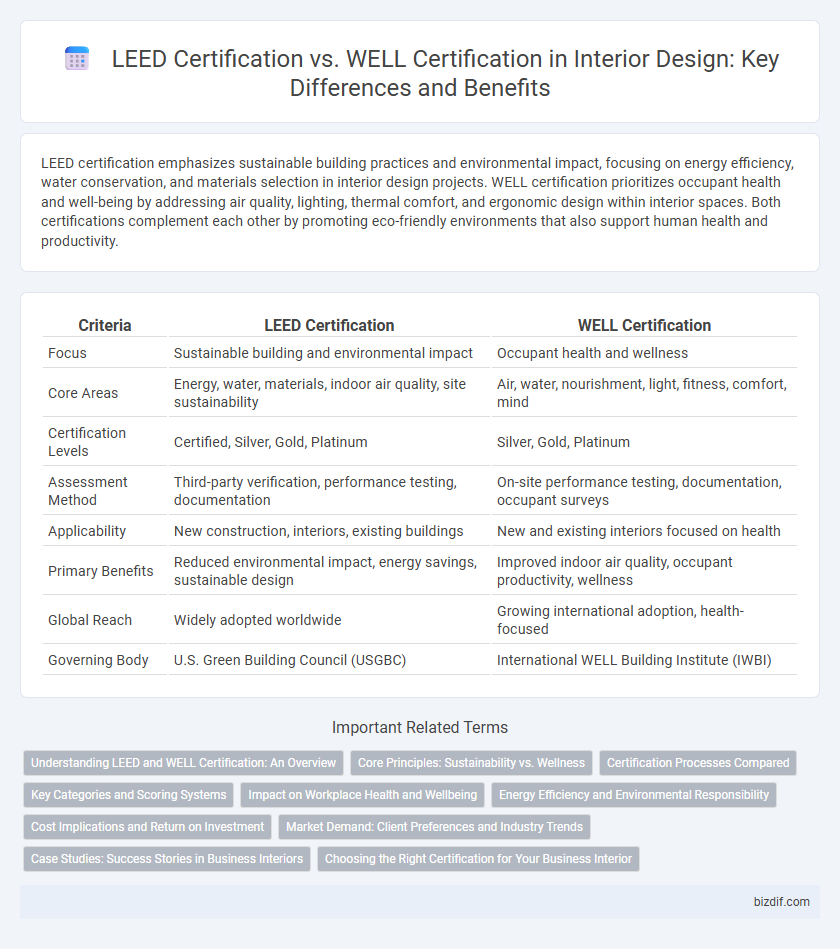LEED certification emphasizes sustainable building practices and environmental impact, focusing on energy efficiency, water conservation, and materials selection in interior design projects. WELL certification prioritizes occupant health and well-being by addressing air quality, lighting, thermal comfort, and ergonomic design within interior spaces. Both certifications complement each other by promoting eco-friendly environments that also support human health and productivity.
Table of Comparison
| Criteria | LEED Certification | WELL Certification |
|---|---|---|
| Focus | Sustainable building and environmental impact | Occupant health and wellness |
| Core Areas | Energy, water, materials, indoor air quality, site sustainability | Air, water, nourishment, light, fitness, comfort, mind |
| Certification Levels | Certified, Silver, Gold, Platinum | Silver, Gold, Platinum |
| Assessment Method | Third-party verification, performance testing, documentation | On-site performance testing, documentation, occupant surveys |
| Applicability | New construction, interiors, existing buildings | New and existing interiors focused on health |
| Primary Benefits | Reduced environmental impact, energy savings, sustainable design | Improved indoor air quality, occupant productivity, wellness |
| Global Reach | Widely adopted worldwide | Growing international adoption, health-focused |
| Governing Body | U.S. Green Building Council (USGBC) | International WELL Building Institute (IWBI) |
Understanding LEED and WELL Certification: An Overview
LEED certification emphasizes sustainable building practices by assessing energy efficiency, water conservation, and use of environmentally friendly materials, promoting reduced environmental impact. WELL certification focuses on occupant health and well-being by evaluating air quality, lighting, fitness, comfort, and mental health factors within interior spaces. Both certifications guide interior design strategies to create healthier, more sustainable environments, with LEED targeting ecological performance and WELL prioritizing human-centric design.
Core Principles: Sustainability vs. Wellness
LEED certification emphasizes sustainability through core principles like energy efficiency, water conservation, and reducing environmental impact, making it a benchmark for green building practices. WELL certification centers on wellness by prioritizing air quality, lighting, comfort, and occupant health in interior design. Both certifications shape design decisions but differ in focus: LEED targets environmental sustainability while WELL promotes human health and well-being.
Certification Processes Compared
LEED certification requires a comprehensive evaluation of a building's energy efficiency, water usage, and sustainable materials, with a point-based scoring system verified through documentation and on-site inspections. WELL certification emphasizes occupant health and wellness by assessing air quality, lighting, fitness, and comfort standards, involving performance testing and post-occupancy monitoring for compliance. Both certifications mandate rigorous documentation, yet WELL places greater focus on ongoing operational performance while LEED prioritizes design and construction phases.
Key Categories and Scoring Systems
LEED certification evaluates sustainability through categories such as Energy & Atmosphere, Materials & Resources, and Indoor Environmental Quality, using a points-based scoring system to achieve levels like Certified, Silver, Gold, or Platinum. WELL certification focuses on human health and wellness, assessing categories including Air, Water, Nourishment, Light, Fitness, Comfort, and Mind, with performance verified through preconditions and optimizations. Both systems require rigorous documentation and third-party verification, but LEED emphasizes environmental impact while WELL prioritizes occupant well-being and experience.
Impact on Workplace Health and Wellbeing
LEED certification primarily emphasizes sustainable building practices and energy efficiency, indirectly benefiting workplace health through improved indoor environmental quality. WELL certification, however, directly targets occupant health and wellbeing by integrating features such as air quality monitoring, natural lighting, and ergonomic design. Incorporating WELL standards creates workspaces that enhance productivity, reduce stress, and promote overall employee wellness more effectively than LEED alone.
Energy Efficiency and Environmental Responsibility
LEED certification emphasizes energy efficiency through sustainable building materials, optimized energy performance, and reduced greenhouse gas emissions, promoting environmental responsibility in interior design. WELL certification, while also supporting energy-efficient practices, prioritizes occupant health and well-being by improving indoor air quality, natural lighting, and thermal comfort. Both certifications drive eco-friendly design, but LEED centers more on overall environmental impact, whereas WELL targets human health within energy-conscious spaces.
Cost Implications and Return on Investment
LEED certification often requires upfront investment in sustainable materials and energy-efficient systems, leading to higher initial costs but strong long-term savings through reduced utility bills and increased building value. WELL certification emphasizes occupant health and wellness features such as air quality and lighting, which can elevate design and construction expenses but potentially boost employee productivity and reduce absenteeism. Both certifications offer distinct return on investment profiles, with LEED focusing on operational cost reduction and WELL enhancing human capital performance.
Market Demand: Client Preferences and Industry Trends
LEED certification remains a dominant market driver in interior design, reflecting strong client preferences for sustainability and energy efficiency across commercial and residential projects. WELL certification increasingly influences industry trends by emphasizing occupant health and wellness, appealing to clients prioritizing indoor environmental quality and biophilic design. Emerging market demand favors integrated certifications that combine LEED's environmental standards with WELL's human-centric approach, shaping future interior design strategies.
Case Studies: Success Stories in Business Interiors
Case studies of business interiors reveal LEED certification often drives energy efficiency and sustainable material use, resulting in significant cost savings and reduced environmental impact. WELL certification focuses on enhancing occupant health and wellness, demonstrated by improved employee productivity, satisfaction, and reduced absenteeism in certified spaces. Combining both certifications in corporate projects has led to holistic environments that balance sustainability with human-centric design, maximizing return on investment and workplace wellbeing.
Choosing the Right Certification for Your Business Interior
LEED certification emphasizes sustainable building practices, energy efficiency, and environmental impact reduction, ideal for businesses prioritizing green construction and operational savings. WELL certification focuses on occupant health and well-being by integrating air quality, lighting, and ergonomic design, making it suitable for companies aiming to enhance employee productivity and wellness. Selecting between LEED and WELL depends on whether your business prioritizes environmental sustainability or human health factors within its interior design strategy.
LEED certification vs WELL certification Infographic

 bizdif.com
bizdif.com